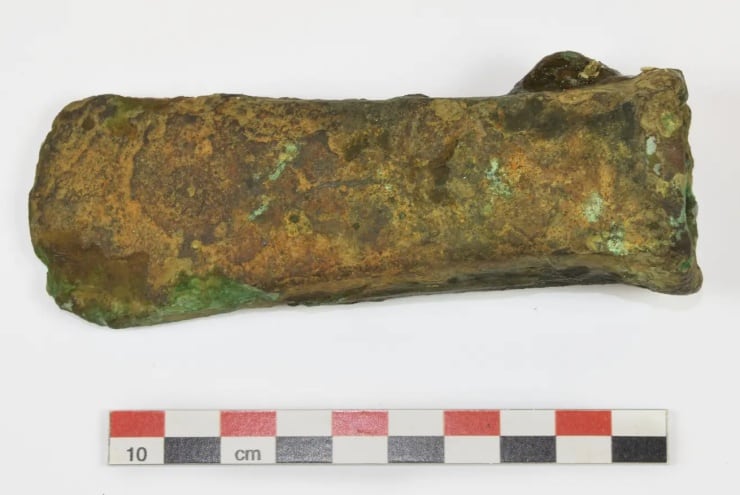A Bronze Age axe has been discovered in the sea off the Norwegian coast
Categories: Nálezy nejenom s detektorem ve Skandinávii , Nálezy nejenom s detektorem kovů v mořích a oceanech
A Bronze Age axe was discovered on the seabed off Arendal in south-eastern Norway at a depth of 12 metres. According to the specific hollow shape, it is specifically from the Middle Bronze Age and dates back to approximately 1100 BC. This is the first prehistoric metal artefact discovered in Norwegian waters and possibly the first evidence of a shipwreck from this period.
The Norwegian Coastal Administration needed to blast away the underwater reefs and therefore the area had to be archaeologically surveyed first. One of the divers was Jørgen Johannessen, an archaeologist at the Norwegian Maritime Museum. That's when I discovered the flint ballast," he explains.
"It used to be used to stabilise the boat during sailing, especially in rough weather conditions.heavy weather conditions," Johannessen said, adding that heavy materials such as stone and sand were loaded on board before setting sail. "Then it was often dumped overboard near the coast. It was a simple and practical way to get rid of ballast before loading cargo such as planks," he explained, adding that this method was used from the 16th century until the 1850s.
"So my mind was tuned to that time," he went on to describe. Suddenly, he saw an object that resembled a Bronze Age axe. "I could hardly believe it," Jørgen described the moment he saw the bronze axe in a layer of flint tubers. "When I surfaced and put it on the deck of the boat, everyone was completely silent," said the marine archaeologist. "I was absolutely amazed by the discovery," he added.
The hollow axe weighs 327 grams, is 11.8 cm long, 4.7 cm at the widest point of the curved blade, 3.3 cm at the narrowest point and has a wall thickness of 5 mm. It was the dominant axe shape in the Nordic Bronze Age (1800-500 BC). It originally had a wooden handle made of curved wood, which was inserted into the open end of the axe and fixed with a tab. It was an efficient and economical design that allowed for maximum functionality using the least amount of then-expensive and hard-to-find metal necessary.
There are two hypotheses as to how the axe could have ended up twelve metres off the reefs, both of which assume that it arrived with the vessel: the shipwreck hypothesis and the ballast hypothesis. If the axe was a remnant from a shipwreck more than 3,000 years ago, it could have come from a ship cruising from southern Scandinavia or a local vessel sailing along the coast. If this hypothesis is correct, it would be the first known Bronze Age wreck site in Norway.
The ballast hypothesis suggests that the axe was dumped together with the flint nodules on its way to the port of Arendal, where the new cargo was to be picked up. In that case, the axe would have ended up on the seabed no more than a few hundred years ago. At that time, the axe would have been a free find with no context other than just as part of the ballast.
That's why archaeologists from the Norwegian Maritime Museum will return to the site this week and examine it thoroughly. They hope to find evidence to confirm one hypothesis or the other. In particular, a Bronze Age shipwreck would be an unprecedented find of national importance.
Roman Nemec
Sources: marmuseum.no, thehistoryblog.com, sciencenorway.no




Jørgen Johannessen

reconstruction of this type of axe

marine archaeologists Frode Kvalø and Jørgen Johannessen
The article is included in categories: